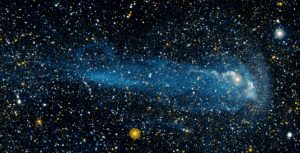Pulsating variable
A pulsating variable is a star that undergoes repetitive expansion and contraction of its outer layers in a periodic way, varying in brightness as it does so. It is a type of intrinsic variable. The behaviour is caused by the tussle between the gravitational forces crushing inwards against the outward forces of radiation and gas pressure. This causes the star’s luminosity to vary.
In many of these variables, including the Cepheids, the period of variation in luminosity, coupled with the star’s apparent magnitude, can be used to calculate distances from Earth. The distance to a galaxy—indeed any other celestial object in the universe— can be calculated if there is a variable star nearby.

A good example is Omicron Ceti in the Constellation Cetus. It is a red giant. Its luminosity ranges from second magnitude at its brightest to tenth magnitude at its dimmest (at which point it is pretty well invisible). The variation occurs over a period of 330 days. The pulsations are caused by internal temperature changes, which are reflected as changes in luminosity. At 2 000°C it is one of the coolest stars in the visible sky. It is at least 15 000 times more luminous than the sun. Internal changes in the star have distended its spherical shape to the appearance of a squashed ball.
Omicron Ceti is the star’s Bayer designation. However, it was originally called “Mira” by an astronomer in the seventeenth century because it behaved like no other star. Mira means “wonderful” or “surprising” in Latin. The alternative use of the proper name has been accepted by the International Astronomical Union, which has classed Mira as the prototype for this type of star. So-called Mira variables are therefore a class of pulsating stars with pulsation periods longer than 100 days, and which are deep red in colour.
Mira will eventually lose its outer layers and reduce to a white dwarf.
Rotating variable
A rotating variable changes in apparent magnitude as various surface features come into and out of view during the period of rotation.
A good example is Procyon A just 11.4 light years away. Its luminosity varies as sunspots cross the field of view. Procyon also has a companion white dwarf called Procyon B, which is about the same size as Earth, and which orbits the main star. It just so happens that its orbit crosses in front of Procyon A , as viewed from Earth. When it does so its luminosity adds to that of Procyon A, boosting its apparent magnitude.
Alpha 2 Canum Venaticorum is another type of a rotating variable where differences in brightness are thought to be caused by strong magnetic fields. This gives rise to different chemical compositions, temperatures and brightness at different parts of the stellar surface.
Eruptive Variable
An eruptive variable star is so-called because its change in brightness is caused by eruptions, such as flares on the surface. This is usually accompanied by an outflow of matter in the form of stellar winds in various intensities that interact with the surrounding interstellar matter. You may also come across the terms “cataclysmic variable”—same thing.
U Geminorium in the Constellation Gemini is the best known and the prototype for the eruptive variable. It is lying 250 light years away. Eruptive variables are dwarf stars that undergo abrupt changes, suddenly becoming 2 to 6 magnitudes brighter. In 1885 U Geminorium suddenly became 9 magnitudes brighter and then disappeared after two weeks. A few months later it returned to its former self before fading somewhat. It is a close binary system consisting of a red main sequence star orbiting and eclipsing a white dwarf and its accretion disc. Material is falling onto this disc causing localised heating and rapid increases in brightness of three to five magnitudes.
By Nigel Benetton, science fiction author of Red Moon Burning and The Wild Sands of Rotar.
Last updated: Tuesday, 2nd March 2021